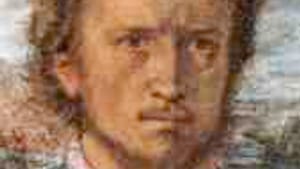Stay in the Loop
BSR publishes on a weekly schedule, with an email newsletter every Wednesday and Thursday morning. There’s no paywall, and subscribing is always free.
The evolution of art, up very close
"Watteau to Degas' at the Frick in New York

Jean-Antoine Watteau and Edgar Dégas are the headliners for a memorable show of French drawing at the Frick Collection in New York, featuring the collection of Fritz Lugt, a 19th-Century Dutch collector with an excellent eye. The show contains many small-scale jewels from some of history's greatest drawing hands, but these quiet, intimate works on paper also provide a fortunate chance to witness the evolution of art from a highly academic period to the brink of modernism.
The exhibit's organization in the Frick's lower level gallery— the first room for early works (all pre-1800) and the second for the late 1700s to mid-1800s— makes the division between periods easy to understand. But the dividing line isn't as definite as one might think.
Watteau, the earliest artist (1684-1721) and one of art's most superb draftsmen, reveals in his exquisite tri-color chalk drawings an extraordinarily modern eye, especially given the confines of his period: the reign of Louis XIV. Watteau's study of a reclining woman, clothed in the luscious excess of the time, rewards careful study with not only a glimpse of lightly veiled nipples, but swirls of brash, fresh strokes as free and modern as the drips of Jackson Pollock.
Turkish joke
Similarly, Watteau's drawing of a man in Turkish dress conveys a slight ironic smirk, a wink at the fact that the subject is most likely pretending his role— and again, the strokes of chalk whiz and zing around the page with a fresh energy that belies the stuffy looking wig.
Fragonard, of Rococo fame, is represented with several examples, the most charming of which is a loosely sketched self-portrait; this diminutive man sits slumped in a chair, looking bored.
Crossing into the second room, one first confronts a Roman soldier as imagined by Dégas in the 1850s. The drawing is an academic study with Renaissance and Mannerist influences, but the look in the soldier's eye radiates startling focus and intensity, recalling Dégas's pioneering fascination with photography.
Artists in this room (and phase) include David, Ingres, Delacroix, Millet and others, with a well-chosen range of subjects. Incredible skill is the hallmark of all drawings by Ingres; but here, in the sweet portrait of his fiancée, Julie Forestier, one catches a rare hint of emotional warmth.
Wide sky, low horizon
Several lovely watercolor drawings can be found in the second room, including an 1849 view of Montmartre by Jongkind, a Dutch artist who moved to Paris in the mid-19th Century. The simplicity of the scene, the wide sky over a low horizon, and the gentle tones of color make the work a fine combination of early Impressionism and Dutch traditions.
Jongkind's contemporary, Daubigny, counters with another Paris landscape, this a careful pencil rendering of central Paris. Since it was done in 1852, shortly before Baron Haussmann began to tear apart old neighborhoods and narrow streets to create the wide-open modern city that we see today, it's a work of historical as well as artistic gratification.
This is a rich show that rewards as much slow careful study as a visitor has time for. The Frick provides magnifying glasses in a rack between the rooms, a welcome aid in the pursuit of delicate and interesting details.
The exhibit's organization in the Frick's lower level gallery— the first room for early works (all pre-1800) and the second for the late 1700s to mid-1800s— makes the division between periods easy to understand. But the dividing line isn't as definite as one might think.
Watteau, the earliest artist (1684-1721) and one of art's most superb draftsmen, reveals in his exquisite tri-color chalk drawings an extraordinarily modern eye, especially given the confines of his period: the reign of Louis XIV. Watteau's study of a reclining woman, clothed in the luscious excess of the time, rewards careful study with not only a glimpse of lightly veiled nipples, but swirls of brash, fresh strokes as free and modern as the drips of Jackson Pollock.
Turkish joke
Similarly, Watteau's drawing of a man in Turkish dress conveys a slight ironic smirk, a wink at the fact that the subject is most likely pretending his role— and again, the strokes of chalk whiz and zing around the page with a fresh energy that belies the stuffy looking wig.
Fragonard, of Rococo fame, is represented with several examples, the most charming of which is a loosely sketched self-portrait; this diminutive man sits slumped in a chair, looking bored.
Crossing into the second room, one first confronts a Roman soldier as imagined by Dégas in the 1850s. The drawing is an academic study with Renaissance and Mannerist influences, but the look in the soldier's eye radiates startling focus and intensity, recalling Dégas's pioneering fascination with photography.
Artists in this room (and phase) include David, Ingres, Delacroix, Millet and others, with a well-chosen range of subjects. Incredible skill is the hallmark of all drawings by Ingres; but here, in the sweet portrait of his fiancée, Julie Forestier, one catches a rare hint of emotional warmth.
Wide sky, low horizon
Several lovely watercolor drawings can be found in the second room, including an 1849 view of Montmartre by Jongkind, a Dutch artist who moved to Paris in the mid-19th Century. The simplicity of the scene, the wide sky over a low horizon, and the gentle tones of color make the work a fine combination of early Impressionism and Dutch traditions.
Jongkind's contemporary, Daubigny, counters with another Paris landscape, this a careful pencil rendering of central Paris. Since it was done in 1852, shortly before Baron Haussmann began to tear apart old neighborhoods and narrow streets to create the wide-open modern city that we see today, it's a work of historical as well as artistic gratification.
This is a rich show that rewards as much slow careful study as a visitor has time for. The Frick provides magnifying glasses in a rack between the rooms, a welcome aid in the pursuit of delicate and interesting details.
What, When, Where
“Watteau to Degas: French Drawings from the Frits Lugt Collection.†Through January 10, 2010 at the Frick Collection, 1 East 70th St. (at Fifth Ave.), New York. (212) 288-0700 or www.frick.org.
Sign up for our newsletter
All of the week's new articles, all in one place. Sign up for the free weekly BSR newsletters, and don't miss a conversation.

 Marilyn MacGregor
Marilyn MacGregor